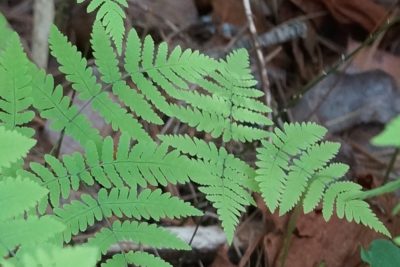Northern oak fern (Gymnocarpium dryopteris)
Very attractive deciduous fern; distinctive trimerous fronds of bright green; unusual ground cover for humus-y soil in moist shade; ranges from Greenland to Alaska, south from Washington to West Virginia.
 Maine is a-green with ferns in summer. Ferns clothe the deepest gloom of forest floors with bright verdancy. They swarm across boulders and up and down escarpments, defying gravity and horticultural expectations by thriving in the thinnest crannies of nourishment. Ferns colonize exhausted fields, clammy ditches, and disturbed sites in full sun; they march along streambeds in Mad Hattery profusion. In shade or in sun, given appropriate moisture, the estimable greenness of ferns is a contrast to many flowering plants that have begun to exhaust themselves.
Maine is a-green with ferns in summer. Ferns clothe the deepest gloom of forest floors with bright verdancy. They swarm across boulders and up and down escarpments, defying gravity and horticultural expectations by thriving in the thinnest crannies of nourishment. Ferns colonize exhausted fields, clammy ditches, and disturbed sites in full sun; they march along streambeds in Mad Hattery profusion. In shade or in sun, given appropriate moisture, the estimable greenness of ferns is a contrast to many flowering plants that have begun to exhaust themselves.
June is the greenest month for all; July, usually less so. Across the landscape, as rainfall dissipates, heat wilts, winds batter, herbivores munch, and pathogens insinuate, the struggle toward reproductive maturity, for many vascular plants, is manifest. Ferns, however, greenly prevail. While Maine summers are ideal for finding ferns in their triumphant multiples of green, their variety and abundance are evident in every season.
Meanders of sensitive fern (Onoclea sensibilis), abruptly browned by the earliest frost, offer the perfect surface for delicate ice crystals: rime makes ephemeral lace out of each leaflet. And even when all the foliage has subsided into a weather-defeated mat, sensitive ferns’ fertile fronds (sporophylls) stand tall.
Hay-scented ferns (Dennstaedtia punctilobula) are perhaps the most kinetic of our ferns, seeming to shimmy and jig, from croziers to yellow senescence. Every part is profuse- rhizomes, blades, bipinnate leaflets- optically dizzying and vibrating even in the stillest air.
Christmas ferns (Polystichum acrostichoides) resist winter’s challenges with deep green patience. There are other evergreen ferns readily found. Some of the woodferns, Goldie’s woodferns (Dryopteris carthusiana) for example, are paler green but persistent and winter-proof despite their tender-looking fronds.
There are evergreen spleenworts, small endemic species who prefer rock crevices, talus slopes, and alpine niches of specific aspect and p.H. Much more accessible year-round in Maine are the rock polypodies represented by two species (Polypodium appalachianum and P. virginianum) and a rare hybrid (P. x incognitum). These are the evergreen gymnasts of glacial erratics; they may shrivel in summer’s extreme heat or contract in a winter drought, but the polypodies quickly rebound and greenly revive with moisture in any form.
In late winter and earliest spring it is time to look for the primordia of fiddlehead ferns (Matteuccia struthiopteris spp. pensylvanica). When just released from dormancy these rusty-scaled giants’ fists clutch peeks of green-fiddleheads about to burst into the new season.
All three of Maine’s largest ferns, the fiddlehead or ostrich fern, cinnamon fern (Osmundastrum cinnamomeum), and interrupted fern (Osmunda claytoniana), erupt almost fantastically in new growth, their croziers as imposing as the mature plants.
The northern oak fern, Gymnocarpium dryopteris, does not possess great drama like the behemoth Osmundaceae, nor does it defy winter’s hardships with persistent fertile fronds or evergreen leaflets. Rather, this small fern slowly takes its place in the fern parade, lives its life in the shade, and disappears quickly at summer’s end. An unobtrusive participant in forest ecology, and yet the northern oak fern has many admirers.
Easy recognition often helps a plant to become “a favorite”, and oak fern is easy to identify. Its fronds are tripartite, an unusual arrangement seen also in the much coarser, larger bracken fern (Pteridium aquilinum). Unlike bracken, oak ferns stand only eight or nine inches tall and the fronds are strongly horizontal. Each stem (rachis) is dark against the jewel-bright green of the pinnae (leaflets). Oak fern’s color deepens as the fronds mature, but never seem to dull or tarnish.
New croziers continue to develop and unfurl throughout the summer, creating a tapestry of filigreed green triangles. The overlap is slight in spite of the density of the fronds; each blade accommodates its neighbor’s need for light (such as it is beneath the canopy). While oak fern isn’t Maine’s smallest fern, there is a Lilliputian delicacy about the plant. It is easy to glimpse The Borrowers’ Arrietty and Homily sheltering under a frond while Pod coils and “borrows” a length of wiry rhizome.
Oak fern has survived numerous reclassifications. Edgar T. Wherry in The Fern Guide lists five attempts at genus names, including Polypodium, Phegopteris, Dryopteris, Thelypteris, and Currania. Wherry writes:
The above long series of combinations, to which at least five more could be added, further emphasizes the complexity of the nomenclature problem in the Oak Fern group. There is now general agreement, however, that these ferns do not belong to any of the genera to which they were assigned prior to 1942 except for Gymnocarpium as redefined by Ching in 1933. Although the validity of that redefinition is open to question, it is here accepted for simplicity.[i]
Wherry’s frustration is palpable: one can almost picture his furrowed brow and slight temper. He hadn’t the advantage of contemporary molecular analysis that has provided much clarity[ii], while confining taxonomy to DNA labs. Gymnocarpium dryopteris first assigned in 1851, is again the name for northern oak fern (Linnaeus had called it Polypodium dryopteris in 1753).
William Robinson (1838-1935), the English garden revolutionary, included the oak fern, then called Polypodium phegopteris), in his section on hardy ferns in The English Flower Garden of 1883. Robinson extolled many North American ferns, noting how well they grow in Britain’s cool, moist climate. He proposed “the marriage of the fern and flower garden”, but this would not have embraced the oak fern with its required shade.
Robinson was advising gardeners upon the heels of a craze called Pteridomania, that had swept through Britain from the 1830’s through the 1890’s. The phenomenon was named in 1841 by George Luxford Edward Newman in Phytologist: A Popular Botanical Miscellany.
As Britain industrialized in the nineteenth century, its growing middle class had a little more time for avocational pursuits and greater opportunity for recreation, even some leisure. A concerted passion for the study and collection of ferns arose among both amateur and professional botanists and gardeners. Ferns also provided a demure hobby and education in natural history for Victorian women. With their cryptic reproductive cycles, only deciphered in the mid-1800’s, ferns presented fewer embarrassments than the more obvious gendered apparatus of flowering plants- never mind the chances for blushes, even shock, in the field of zoology.
Pteridomania was not restricted to the rich and idle. Burgeoning railways offered relatively quick, inexpensive, and democratic access to the countryside’s “natural” landscapes. Labor and social welfare laws gave working men and women some unstructured hours; knowledge that may have been a rural worker’s bread-and-butter and culture was suddenly an exalted near-national pursuit.
Why ferns? Having been mysterious, even frightening for centuries, ferns were a final botanical frontier available for discovery and now near at hand. It is ironic that the British coal seams that both fuelled industry and disastrously polluted London, Manchester, Birmingham, and Glasgow, were “laid down” by Carboniferous ferns. City dwellers fled to the countryside to gasp for fresh air and search for the descendants of the plants that were altering their lives.
Fern collecting was given a boost by Nathaniel H. Ward’s 1829 invention of a portable greenhouse designed to protect seedlings and plants sent back to Britain from her outposts all over the world. The Wardian case was perfected, miniaturized and embellished over the next few decades to become a perfect ornament of Victorian parlors. Ferns were happy to grow in the cold gloom of heavily draped, crepuscular rooms. Patterns of ferns, fern motifs, ferns printed on or into textiles, carved on moldings or furniture, rendered in plaster or stone, ferns raged through the decorative arts. The crescendo was the conservatory or great glasshouse, some modest, some large enough to house tree ferns and other exotica from the southern hemisphere.
Undoubtedly there was scientific merit in this new acquaintance with native ferns. But pteridomania took its toll in over-collection, even extirpation of small populations, rarities and endemics. There is still an argument about how much damage was done by the rapaciousness of some collectors because ferns had not been well-studied before they attracted so much attention. Of particular interest to the fern enthusiasts were the plants with odd leaf forms: crinkled tips, polymorphisms; fasciation-like leaflet distortions.
The great abundance of ferns, and the relative absence of fern oddities, are cited as the reason Pteridomania never caught on in America. It is perhaps more likely that American gardeners of the later 1800’s were developing an interest in plants that represented civilization and domesticity, turning their backs on wild, indigenous treasures like native ferns.
Ferns have been in and out, and back in fashion for more than a century in this country. Of late, ferns have enjoyed a resurgence, in part because there is greater appreciation for shade-gardening and gardens that provide habitat for a diversity of fauna. While few ferns provide food for wildlife, they provide essential cover, nesting places and nesting materials. Ferns stabilize soil in places many other plants cannot grow.
The oak fern with its shallow roots and general air of delicacy is an ideal groundcover beneath large trees, nestled among the knobby flanges of roots. Shade, moisture, good humus-y soil, and fine leaf litter will keep a drift of oak ferns happy. Companion plants should be chosen carefully, lest the northern oak fern be eclipsed by taller, more aggressive plants. Spring ephemerals will behave well enough, but really the oak fern has enough beauty to stand alone.
In nature, ferns often germinate in moss, in a rotting log, or in damp exposed soil in shady locations, such as by a stream. Fern spores can be propagated indoors on a bright windowsill, out of direct sunlight, or under a grow light. See the fern propagation section on the website for detailed instructions. The oak fern can be propagated by dividing the roots in the fall or very early in the spring, well before the new fronds are ready to unfurl. In Maine, many nurseries still sell ferns dug from the wild; this is often damaging to wild populations and makes it difficult for nurseries who propagate plants to compete. When purchasing ferns, ask if they are nursery propagated.
By Pamela Johnson
[i] Wherry, Edgar T. 1995. The Fern Guide. New York: Dover. P. 64.
[ii] For a history of taxonomy’s journey from cultural instinct to microscope slide, see Carol Kaesuk Yoon’s Naming Nature (W. W. Norton & Co., 2009).

